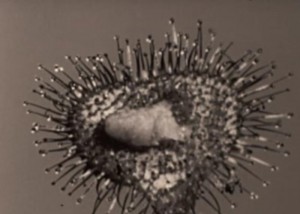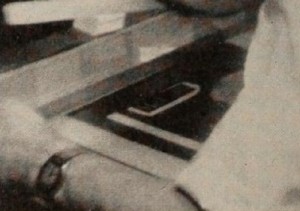"'Indian Summer,' properly may be termed a poem on film. Bert Seckendorf took his camera into the great outdoors one autumn day and photographed many beautiful autumnal scenes which he then skillfully knit together in a smooth flowing pictorial continuity. Scenes of colorful autumn foliage, falling leaves, blue Indian Summer skies, lazy rivulets carrying tiny sailboats of leaves toward the sea -all add up to an impressive ten minutes of screen entertainment. Seckendorf photographed this picture with a Cine Special and Kodachrome film." American Cinematographer, Apr. 1950, 146.
"An Indian brave keeps his ear to the ground in vain!" Oldfilm.org
"Film footage moderately edited with added intertitles, shot in Ceylon, Egypt, and Italy by oil explorer and geologist Walter Link during his personal vacation, records various tourist destinations. Landmarks include: the beach and harbor at Colombo, Sri Lanka (Ceylon); the Sphinx, pyramids, Mosque of Mohamed Ali and Egyptian Museum in and around Cairo, Egypt; Villa San Michele in Capri, Italy; and St. Peters and the Coliseum in Rome, Italy. Footage consists mainly of sights and structures, and features little interaction with local inhabitants," Human Studies Film Archives, Smithsonian Museum.
"ASIDE from the honorable mentions already noted, another was given to Koji Tsukamoto,of Tokio, Japan, for his lovely 9 millimeter entry, "The Inland Sea of Japan." This contestant achieved some astonishing results with a difficult medium." Photoplay, Nov. 1929, 86

"Dr. William M. Harlow is professor of Wood Technology at the State University of New York, College of Forestry. His film records the unparalleled spectacle of live insects being trapped by the pitcher plant, the sundew and Venus flytrap. Expert close-up photography and effective time lapse sequences employing home made equipment includes material never before recorded on film. A top flight nature film with suspense and drama, carrying a powerful appeal to any audience." PSA Journal, Dec. 1955, 35.

"No matter how one feels about the outside cover of a magazine, George E. Valentine's The Inside Story of the Outside Cover will be a surprise. If you think that the production of four color engraving plates is a simple matter, you will do some quick revising of your thinking. If you have a certain admiration for the technical skill that goes into such work, that admiration is likely to be heightened by Mr. Valentine's step by step story of the creation of a four color magazine cover. Aside from the story it tells, Mr. Valentine's film is a real technical achievement because of the working conditions under which most of the shots were of necessity filmed. His peak sequence — a proof-press run analyzed in slow motion — was achieved by mounting the camera directly on the moving press. When you can do that, you're good." Movie Makers, Dec. 1947, 539.
Total Pages: 299